From Issue Two of the Gear Patrol Magazine. Subscribe today and shipping is on us.
In the past decade, the mezcal industry has undergone a transformation. With the help of a few dedicated brands — Fidencio, Koch el Mezcal, Pierde Almas — the agave spirit emerged from relative obscurity and quickly garnered a loyal following outside of Mexico. What was once only a heritage craft is now a feasible economic opportunity, delivering change to rural communities across the country. “Sons of mezcaleros are coming back from the states to work at the palenques. It’s a new reverse migration, because we’ve actually created an economically viable frontier here,” says Jonathan Barbieri, the owner of Pierde Almas. And as business grows, the old ways are also shifting. Carlos Moreno, the co-owner of Koch el Mezcal, nods towards the changing dynamic: “The maestros are in charge of the mezcal production, but the younger people, sometimes their kids, are in charge of the business.” In small villages in the southern state of Oaxaca, distillers and their partner brands are bringing this ancient tradition into the modern world.
Enrique Jiménez
Maestro Mezcalero, Fidencio
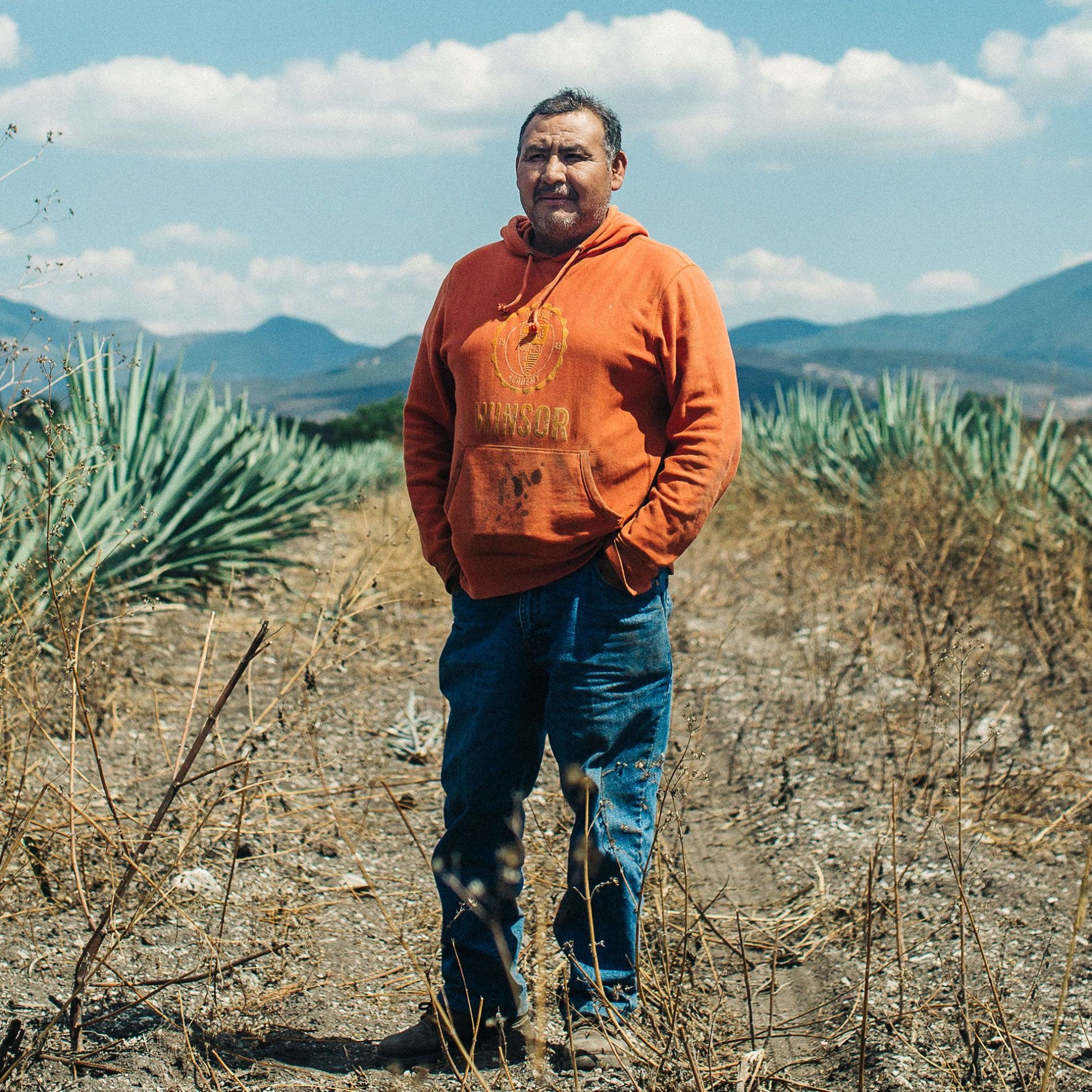
An hour southeast of Oaxaca City, the town of Santiago Matatlán is nestled among rolling hills lined with rows of dusty green agave. Brightly colored one-storey buildings border the highway, and through their open fronts, travelers can see rows of clear bottles, adorned with unfamiliar labels. This is mezcal country, and a sign above the town’s entrance — with an alembic copper still bolted to it — proclaims: “World Capital of Mezcal.”
Outside of Matatlán, Maestro Mezcalero Enrique Jiménez, 55, drives a John Deere tractor along rows of espadín — a variety of agave with long, sword-like leaves — tilling the dry and rocky earth. Of the hundreds of agave species, just over 30 are used to make mezcal, and from those, espadín is the only varietal that is easily cultivated. It is resistant to plague, can grow in a range of climates and soils, and has high sugar content, a plus for distilling. Jiménez’s farm has espadín ranging from a few years to over a decade old, the latter of which are ready to be harvested and taken to the palenque. At the time of harvest, workers use machetes to cut the leaves from the plant, leaving the exposed agave core, known as a piña (because of its resemblance to a giant pineapple). Espadín piñas can weigh over 100 pounds, and moving the harvested agave is backbreaking work for the mezcaleros. After 45 years of making mezcal, Jiménez exhibits a jovial confidence and says, with a laugh: “It’s my life.”
Jiménez’s palenque is at the bottom of a hill along the highway, surrounded by a tall iron fence, with a large sign reading “Mezcal del Amigo.” The entryway is paved with smooth stones and the building proudly promotes the palenque’s association with Fidencio Mezcal. In an open-air workspace, a framed image of the Virgin of Guadalupe hangs above a large stone mill, and rows of fermenting vats sit in a shaded back corner. The wooden vats are chest-high and have open tops, allowing the mashed agave to interact with wild yeasts. The surfaces of the vats are alive with movement, small bubbles breaking the surface every second, and the air is filled with a sweet and vegetal smell. The vats that have been fermenting the longest, almost a week, have fewer bubbles rising to the surface and are almost ready to be added to Jiménez’s stills a few feet away.
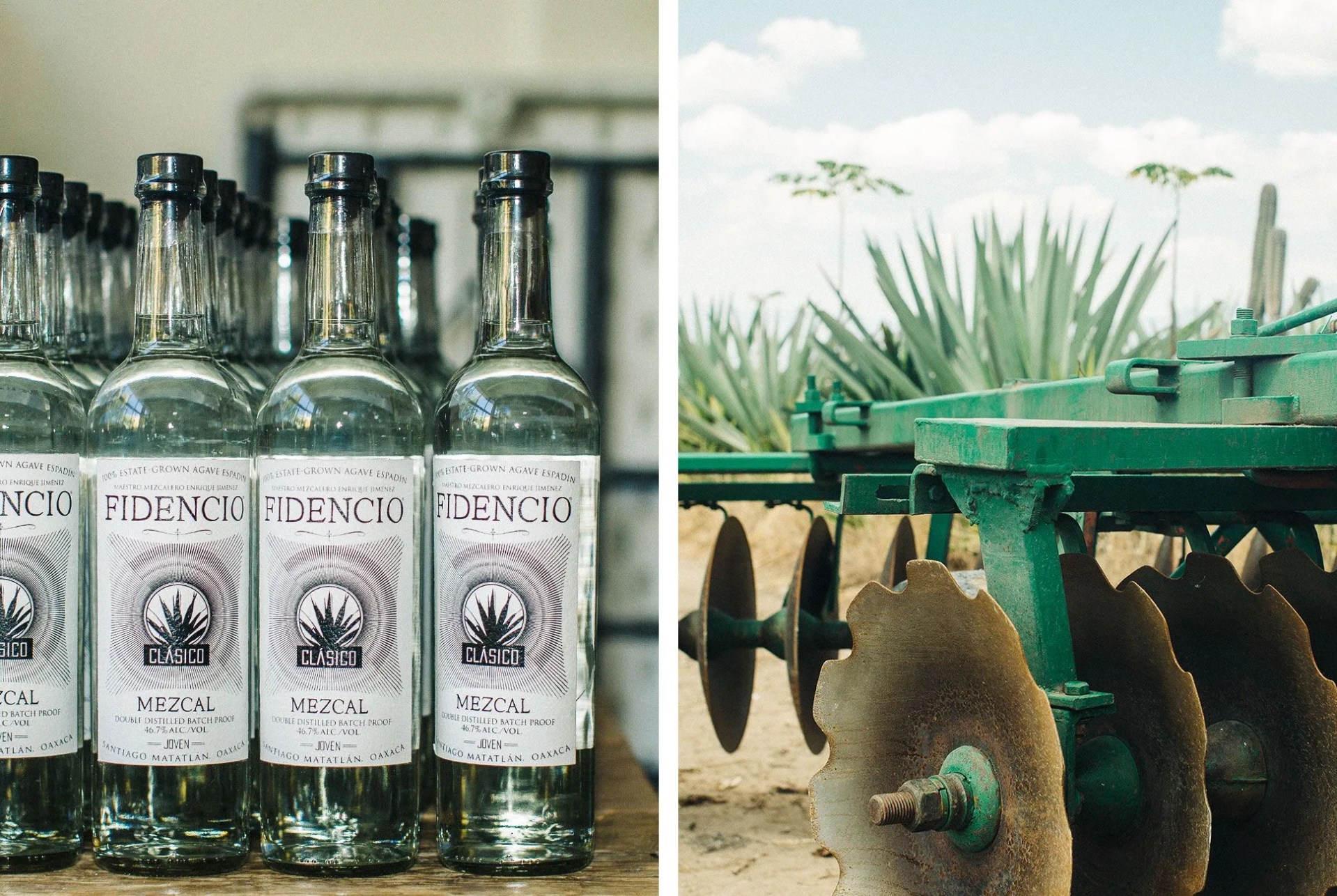
“At Fidencio, we make the mezcal traditionally, but we want to incorporate some modern wisdom,” says company co-founder Arik Torren. For example, Jiménez, who went to university to study chemical engineering, still roasts agave in a traditional earthen pit, but he also cooks piñas in a specially designed radiant heat oven to deliver an unaffected agave expression. “He has a Western education on distillation and science,” says Torren. “With that also came the ease in communication on documentation, registration, and a professionalism that is needed to do business.”
Smoke rises from underneath a row of four copper pot stills, and the quiet murmur of liquid trickling into large jugs provides undulating background noise. Jiménez’s daughter, Alina, walks through the palenque, checking emails for Fidencio on her cell phone. She wears sneakers, ripped jeans and a stack of bracelets on one arm. An agave tattoo adorns her other arm. Though generations of men have learned the traditions of mezcal production for hundreds of years, more and more young women in Oaxaca are showing interest in the craft and the business. A chemical-engineer distiller and his daughter: this is mezcal in the 21st century.
Pedro Hernández
Mezcalero, Koch el Mezcal
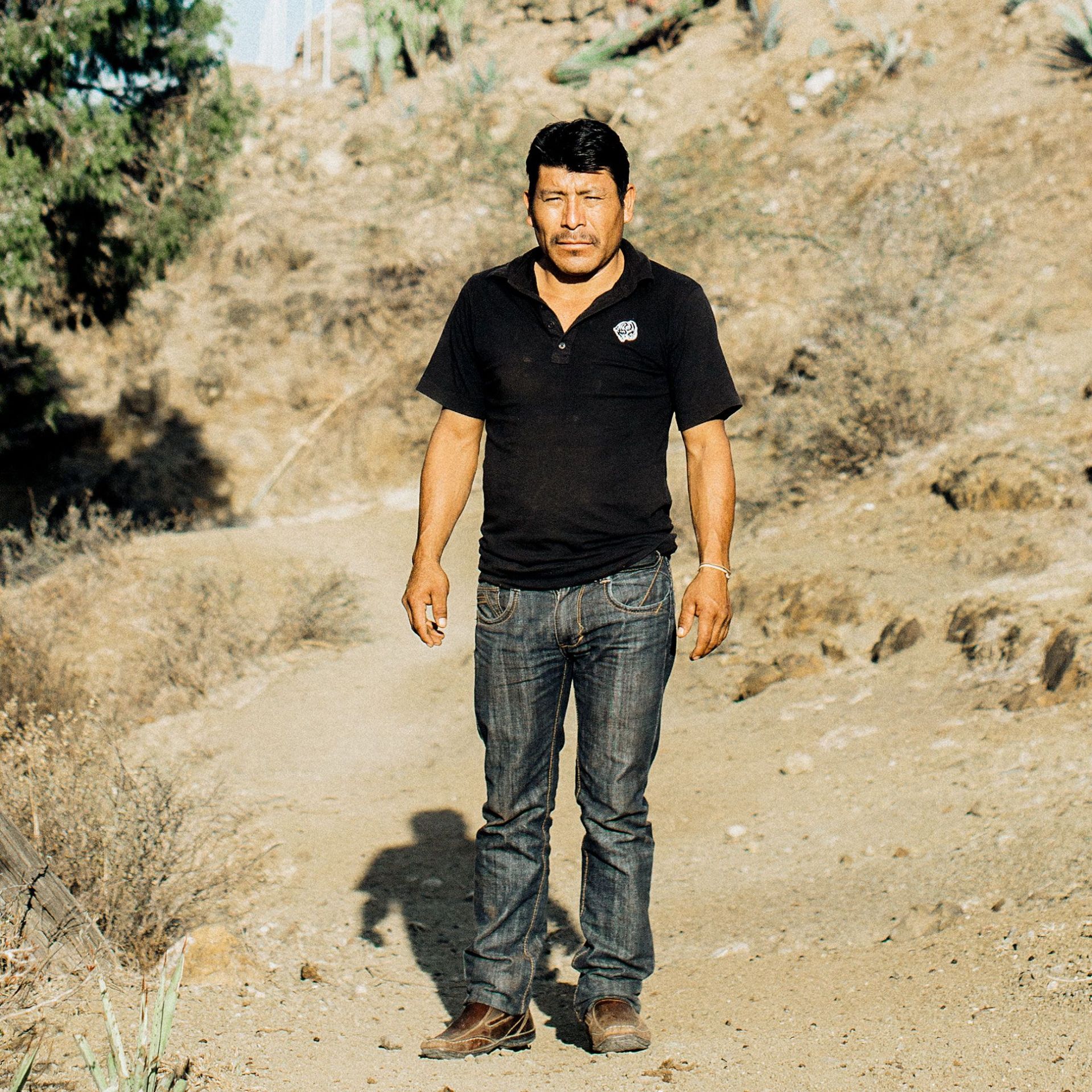
The sun has not yet come up in Santa Cruz Xoxocotlán, but the air is veiled with smoke. Two copper alembic stills are producing a slow stream of mezcal, while a group of a dozen men ranging in age from 20 to 50 stand around sipping instant coffee, trading jokes in the indigenous Zapotec language. Nearby, a fire is dying down in a large conical pit filled with a small tower of river stones. A signal is given and the men leave their drinks, picking up axes and wheelbarrows, setting to work on a sprawling mound of espadín piñas lying near the pit. The rhythmic thud of axe heads splitting piñas rings through the early morning air as the workers quickly and methodically stack the quartered pieces. 33-year-old Pedro Hernández, a sixth-generation mezcal producer who distills for Koch el Mezcal, looks over the waist-high ring of agave, waiting for the pit to stop smoking. He knows if the piñas are added to the pit too early, the resulting mezcal will taste overtly of wood smoke, and the subtle nuances of the plant will be overshadowed.
After another round of coffee, the rocks in the pit are red hot and all of the combustible material has burned. The rocks are covered and the workers start piling the pieces of agave into the pit — a display of raw strength and long-rehearsed technique. To best pack the espadín for roasting, the men lift each piña as high as they can before throwing it into the pit. The agave is heaped well above the lip and is then quickly covered with oversized tarps. It’s an intense physical effort from those involved — the pit holds over 10 metric tons — and it all happens before the sun has crested the mountains. Hernández then climbs atop the mound and secures a sheet over the smoldering piña as smoke rises around him. Small logs, around three feet long, are then stacked around the mound and covered with dirt, effectively sealing in the heat for a multi-day roasting period.
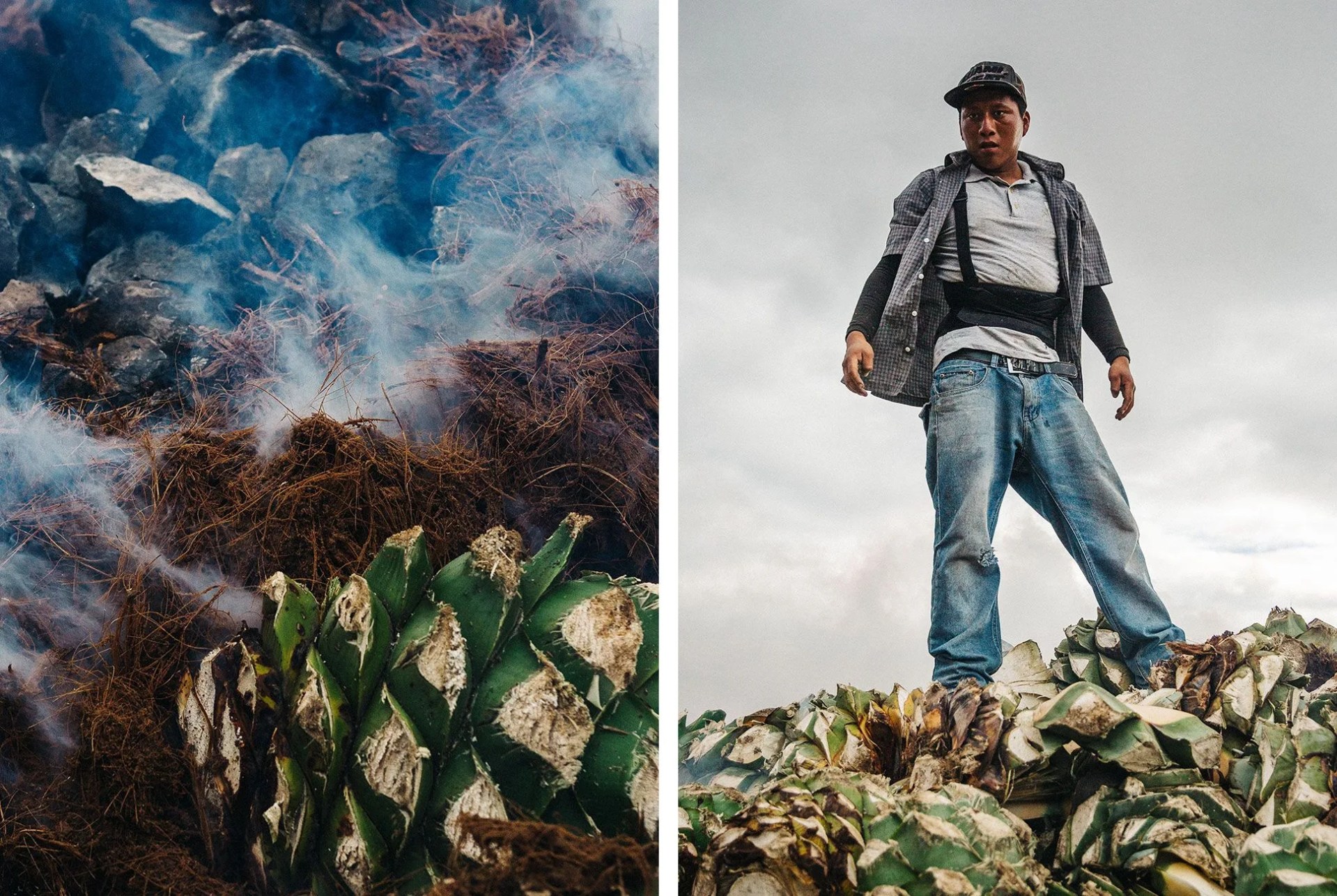
Hernández also owns another palenque an hour and a half away in the sun-washed hills of San Baltazar Guelavila. Here, in the early morning light, a man guiding two donkeys carrying harvested wild agave ambles past. “It’s getting more and more difficult to have enough wild agave,“ says Maarten Vandecuater, who directs foreign trade for Koch. “It’s almost impossible to produce big volumes of wild agave because of the environmental impact and the price. And also, it’s just difficult to find them.” Wild agave is linked closely with the microclimate in which it grows, making it hard to cultivate outside of its unique growing area. And, to add to the rarity, some wild agaves can take over 20 years to mature. This fact, along with increasing rates of depletion, have inspired sustainability-minded brands to seed agave in the wild. To support local communities, brands wanting to use both the planted and wild agave must buy the harvested plants from people who have permission to work the mountains and hills. Though property in villages and towns can be private, most land in surrounding areas is designated as ejido, a communal land area governed by town leaders. Much of the time, agricultural products grown on this land are split 50/50 between the village and the harvesters or producers. “Communal land is very helpful for people who don’t have the ability to put the work in, and it’s helpful to us,” says Arik Torren, who imports Koch to the United States. “It gives us the opportunity to have more product without buying land.”
Working in remote villages presents a complex set of challenges for any brand, as the majority of municipalities are governed by usos y costumbres (indigenous laws and customs). “It was so difficult when we started to bottle, we gave work to the women from San Baltazar,” says Carlos Moreno, the co-owner of Koch el Mezcal. “One day when I was leaving, men with guns stopped me and asked why I was giving work to the women, because no women had the right to work there. Actually right now, the women there can’t own land.” In the seven years since Koch was founded, tensions have subsided. Torren notes, “In Ejutla and San Baltazar — both with Koch — all of the labeling and bottling is done by women. That’s a new opportunity for economic growth because in both of those villages women never earned money, they just worked in the home. And now those people are gaining independence.”
Gregorio Velasco
Maestro Mezcalero, Pierde Almas
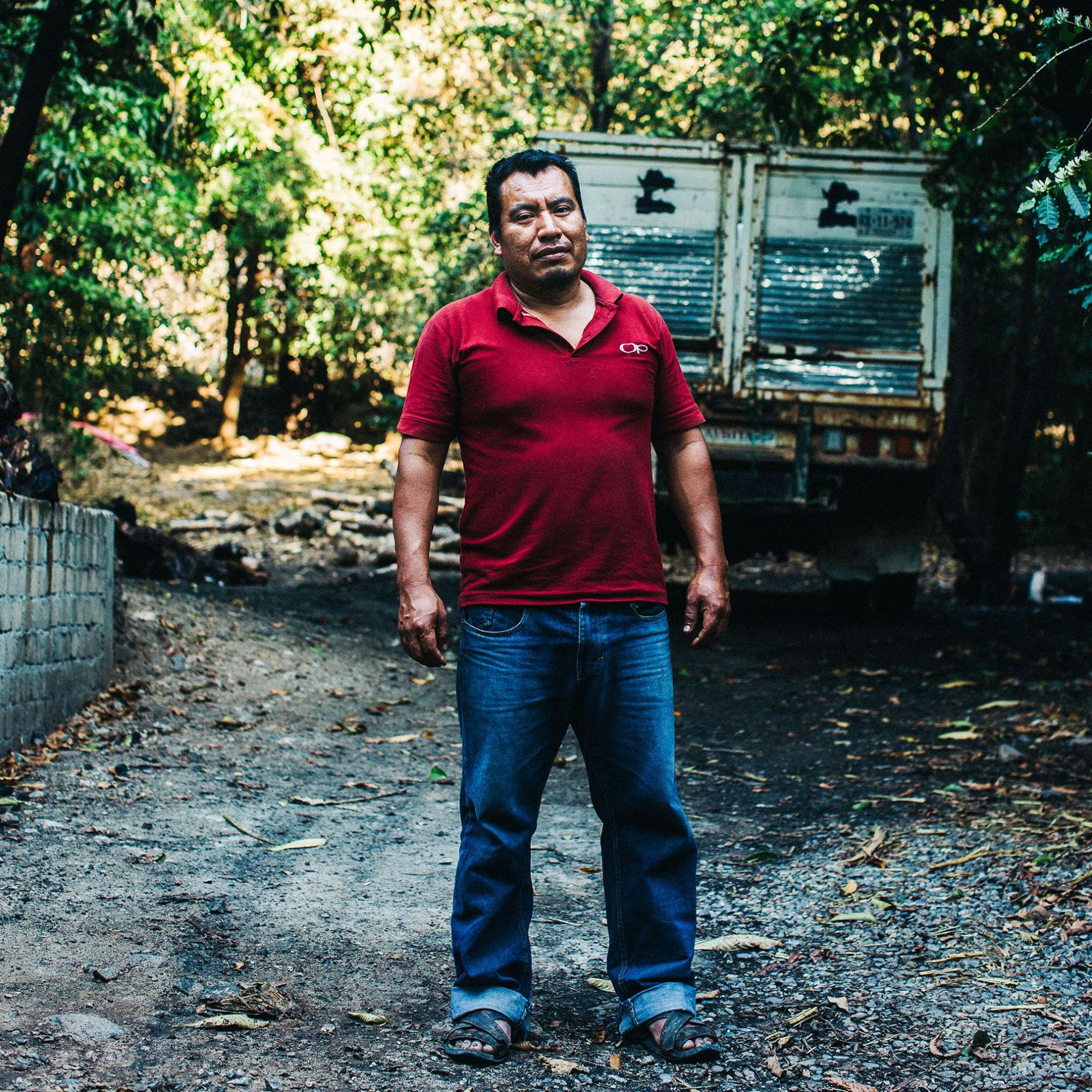
The closer you get to San Luis del Río, driving southeast from Oaxaca City, the more twisted the road becomes, winding past steep mountains abloom with flowering tepextate. The remedy for carsick passengers in these parts is a short pour of mezcal, to be sipped through the tightest of turns. San Luis del Río sits on a steep hillside overlooking a winding river valley, spotted with numerous palenques. This is where Gregorio Velasco, 38, and a third-generation maestro mezcalero distills for Pierde Almas. From his house, situated on the midpoint of a steep hill, Velasco is a short walk from his palenque. Next to the earthen oven where he recently roasted a batch of tobalá, a large stone wheel called a tahona is set up on a circular stone basin. The wheel is pulled by a horse, milling the roasted agave into a mash that’s easily fermentable. The shade of an ancient chicozapote tree provides the horse much-needed respite from the pounding sun. To produce enough mash to half fill a fermentation vat, the horse must work a full day. Though more commercial mezcal enterprises use machines similar to wood chippers to shred the roasted piñas, artisan mezcal producers opt to use time-tested methods to produce a higher-quality product.
Before Velasco made his living as a mezcalero, he worked construction in Santa Monica. But, before he left Mexico for California, he planted a plot of agave plants he knew would take eight years to mature. During his time in California he saved all the money he made, and upon arriving back in Oaxaca to a field of mature agave, had enough to build a palenque. Velasco’s mezcal found a champion in the owner of Pierde Almas, American expat Jonathan Barbieri.
“I’ve got one foot in the 16th century and one foot in the 21st century,” says Barbieri. Of the 32 years Barbieri has lived in Oaxaca, 27 have been in villages. Barbieri founded Pierde Almas in 2008, and set a high standard for artisanal product and philanthropy. “We’re really firm about giving something back,” he says. In the small village of San Luis del Río, Pierde Almas has donated new basketball hoops for the kids and medicine and supplies for the medical clinic. Barbieri also plans on creating a library for the community, complete with donated books and lectures on computers.
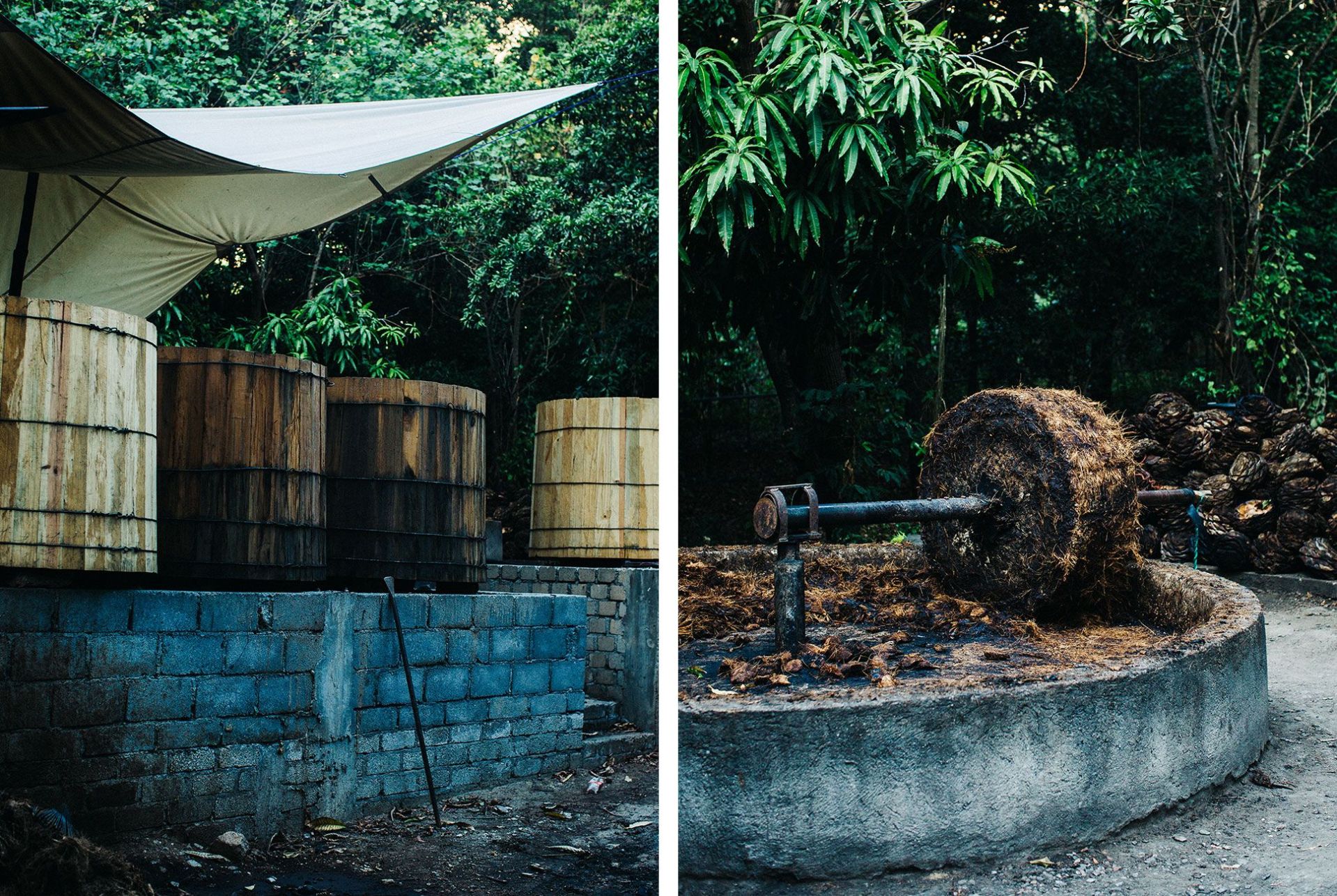
“The story is about [Velasco] and his father and his grandfather. It’s about the ecosystem here, it’s about the fact that someone planted these trees, it’s about a tradition, it’s about different villages that have different traditions for flavor profiles, it’s a whole social tapestry and I’m just the middle man,” says Barbieri, who also helped Velasco build a cement foundation with walls to house his pine fermentation vats. The walls help contain the heat generated by the fermentation process and lead to a more consistent time frame and, in turn, a more consistent product. The mixture of mashed agave and local water interact with 14 wild yeasts, and over a few days, a natural clay-like pumice builds up on the top, a byproduct that allows the yeasts to live in an anaerobic environment. Velasco tastes this mixture as it progresses from sweet to astringent, and listens to the bubbling dissipate as the yeasts die off from the alcohol they themselves created. The whole fermentation process can take six to eight days, and though commercial productions use ammonium nitrate to speed the process to a matter of hours, Velasca and Barbieri aren’t willing to compromise quality for time.
“I thought it was really important to discern the differences between different varieties and different villages,” says Barbieri. “Because the fact is: you can have one variety that grows in a range of 2,000 feet — between 5,000 and 7,000 feet above sea level — and grows in little corners of the macro-environment of Oaxaca that create little microclimates and have micro-terroirs, and and each village has distilling traditions that affect the flavor profile. And that’s not just happenstance. It just so happens that the wild residence yeast encrusts not only the walls of the wooden fermentation vats but also the beams of the distillery, creating a biological dome around the distillery which creates a certain specific, geographical relevance.”
Three donkeys and a horse stand tethered amongst the fruit trees near two copper stills, which are protected by a slanted metal roof. Though regional production methods reflect generations of intuitive practice, an infusion of new ideas from an expert like Barbieri can make for a better product. “I believe that traditions are organic, evolutionary processes,” says Barbieri. “For a tradition to be alive and not a museum piece, it’s got to be able to be alive and grow.”
Alberto Vasquez
Mezcalero, Koch el Mezcal
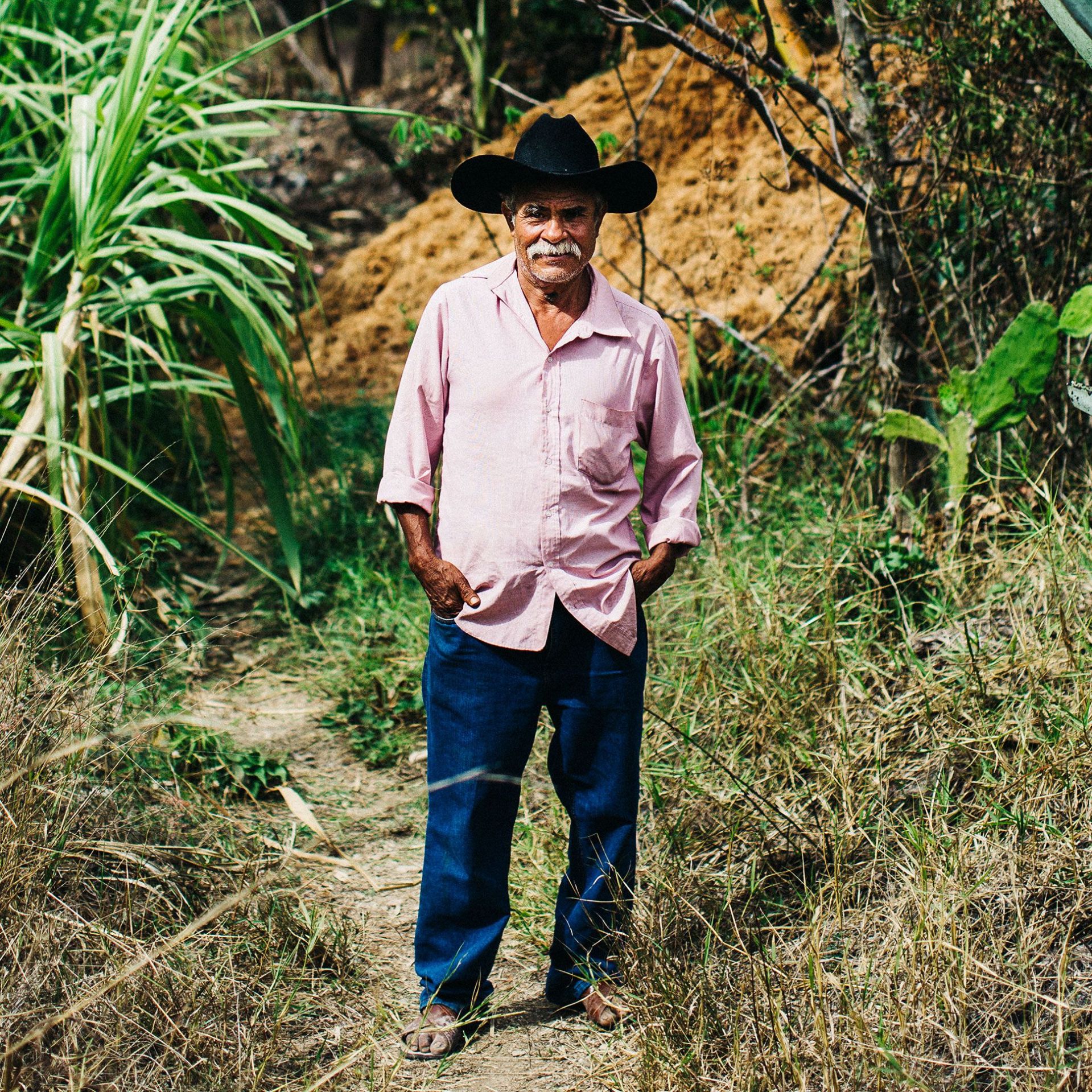
Two and a half hours southwest of Oaxaca City, a serpentine mountain road descends into the town of Villa Sola de Vega. Situated near a river of the same name, a small palenque owned by Don Alberto Vasquez, 65, is nestled among a grove of banana and papaya trees. Along an unnamed dirt road, a few minutes from the gurgling stills, is a nursery field of yearling tobalá, the most notable agave from the valley. Though the short agave with squat tongue-shaped leaves is technically wild, it grows so well in this region that it can be cultivated without notable loss of flavor or sugar content. After a few years of growth, the tobalá plants will be replanted with the help of Vasquez’s sons, Elias and Miguel, in the rugged hills around the palenque.
The tobalá here is smaller than in San Baltazar, and on first glance resembles a wild variety of agave known as coyote. A layer of complexity in the mezcal puzzle, the same variety of agave growing across the state of Oaxaca can look different from place to place, and sometimes can be called by different names. “Cirial is very confusing because each community calls it by its own way,” says Carlos Moreno, of another agave varietal. “Real Minero from Graciela [Angeles] calls it largo, we call it cirial and Ejutla calls it tobasiche. It’s the same agave but each area gives it a different name.”
Mezcal is hyper regional, and everything from the geography to what a plant is called affects the flavor of the final spirit. “You end up having geo-linguistic fault lines that determine the grandfather recipes and flavor profiles of these mezcals,” says Jonathan Barbieri. “So that, although there may be genetic differences between these plants, the real difference lies in the inculturation of the flavor. Because if you call something differently, then chances are its qualities are different and you name it differently and it tastes different. So here we’re talking about appellations, much like in the case of French wines.” The vast range of mezcal now available is made possible by the cultivation of this diversity. Brands are consciously seeking out and differentiating between specific regions, villages, producers, plants and techniques.
Vasquez, an older man with a warm smile shadowed by a thick mustache, makes mezcal with methods unaffected by passing centuries. His small palenque has a corrugated tin roof sitting atop natural beams set into the hillside. The pit in which he roasts agave is noticeably smaller than the pits in Xoxo or Matatlán. After the agave is roasted, Vasquez crushes the malleable piñas in a shallow wooden trough with a carved wooden hammer. The long-handled tool makes short work of the roasted agave, separating the pieces of the heart into short, fibrous strands while squishing stored liquid from the plant. It’s hard physical labor, and Vasquez prefers to work with the leafier tobalá or coyote plants, as opposed to the trunky tobasiche or madrecuixe plants, which take many more sweat-soaked hours to break down.
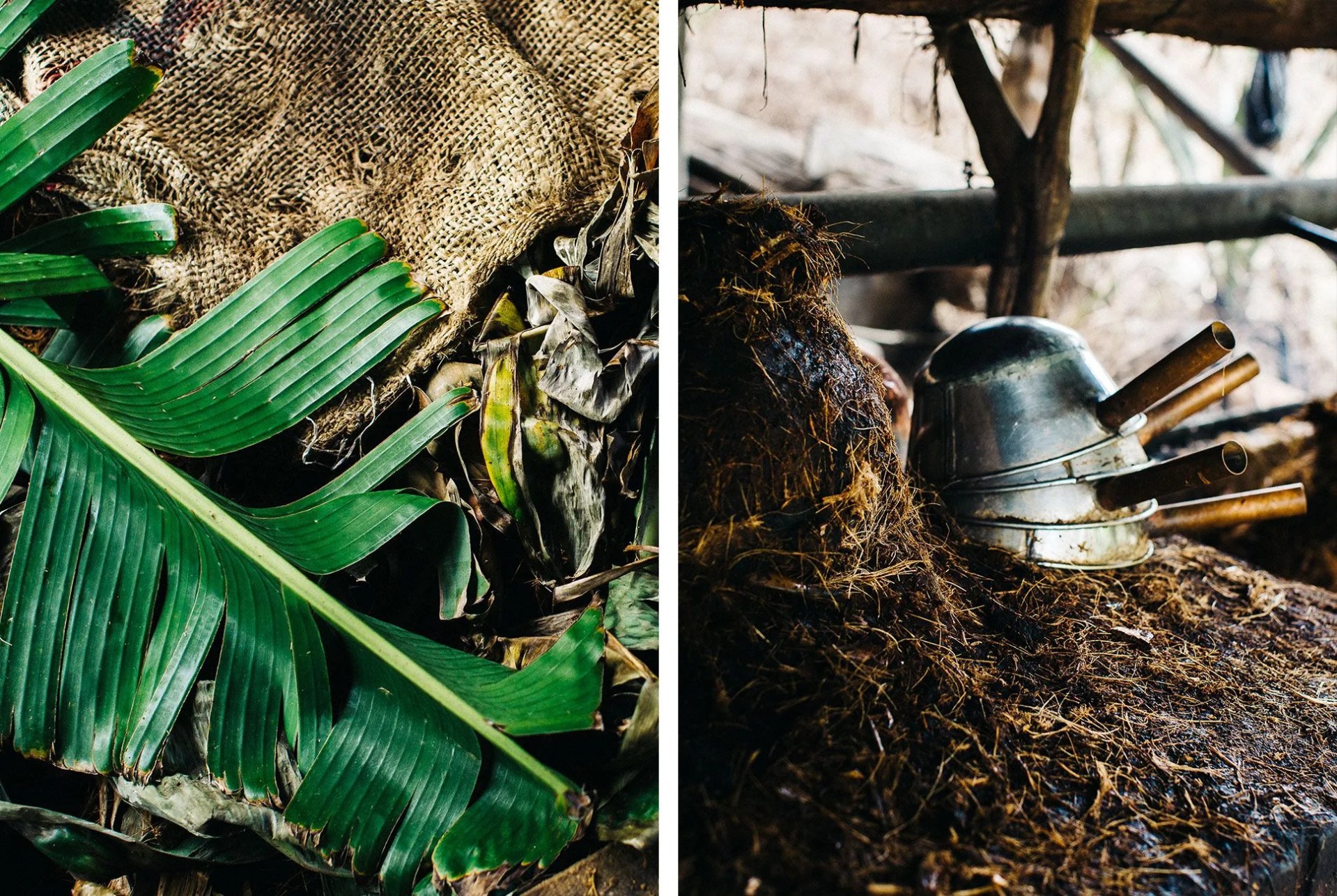
Vasquez’s son Elias rips off a small piece of roasted tobalá to chew on. Its nectar contains a pleasant mix of sweet fruity notes with light earthy undertones. Everything at this palenque is human-sized, built with ancient production methods in mind. The small scale allows Vasquez and his sons to work efficiently without the help of donkey-powered mills or machines. Next to a patinated fermenting vat, another wooden mashing station, shaped like a large mortar and pestle, awaits the freshly roasted agave. Vasquez also prefers to cover his fermenting mixture with banana leaves from the local trees. An intoxicating perfume — scents of fruit mixed with the sweet booziness of fermentation — fills the air, while a small lizard crawls up the side of a vat and a nearby donkey breaks the calm with a loud bray. After 50 years of making mezcal, knowing when it’s time to distill comes naturally to Vasquez. From listening to the bubbles, smelling the mixture and giving it a taste, he will know exactly how many more days and hours are needed.
Vasquez is a master of clay-pot distilling, a method more rustic than its alembic counterpart. The process produces less mezcal than copper-pot distilling, and the resulting mezcal is noticeably different. Because the fermented mixture is heated in semi-porous clay pots, the mouthfeel of Vasquez’s mezcal is smooth and round. Vapors condense on a copper lid, then fall onto an agave-spear spout before trickling into a waiting jug. The bottled spirit has a complex earthy background note that lingers gently on the palate. Vasquez has a mat set up on the floor of his palenque, so that he and his sons can tend the fire of the stills through the night.
Across Oaxaca, the mezcal business has seen a wide range of changes, from the implementation of new innovations, the confrontation of social norms and a fostering of renewed interest in the craft. Even in Vasquez’s rural Sola de Vega, where historic methods are essentially unchanged, he is seeing the impact. Though his sons weren’t originally interested in learning the traditions of mezcal, an increase in production and a viable source of income facilitated their entry into the tradition four years ago. “I’m proud my sons have taken up this craft,” says Vasquez. “I was worried for a moment that it would get lost, but now there is an interest. People are willing to learn how their great-great-grandfathers learned to make mezcal.”
Read More in Our Magazine

A version of this story appears in Issue Two of the Gear Patrol Magazine, 286 pages of stories, reports, interviews and original photography from five distinct locations around the world. Subscribe Now: $39
